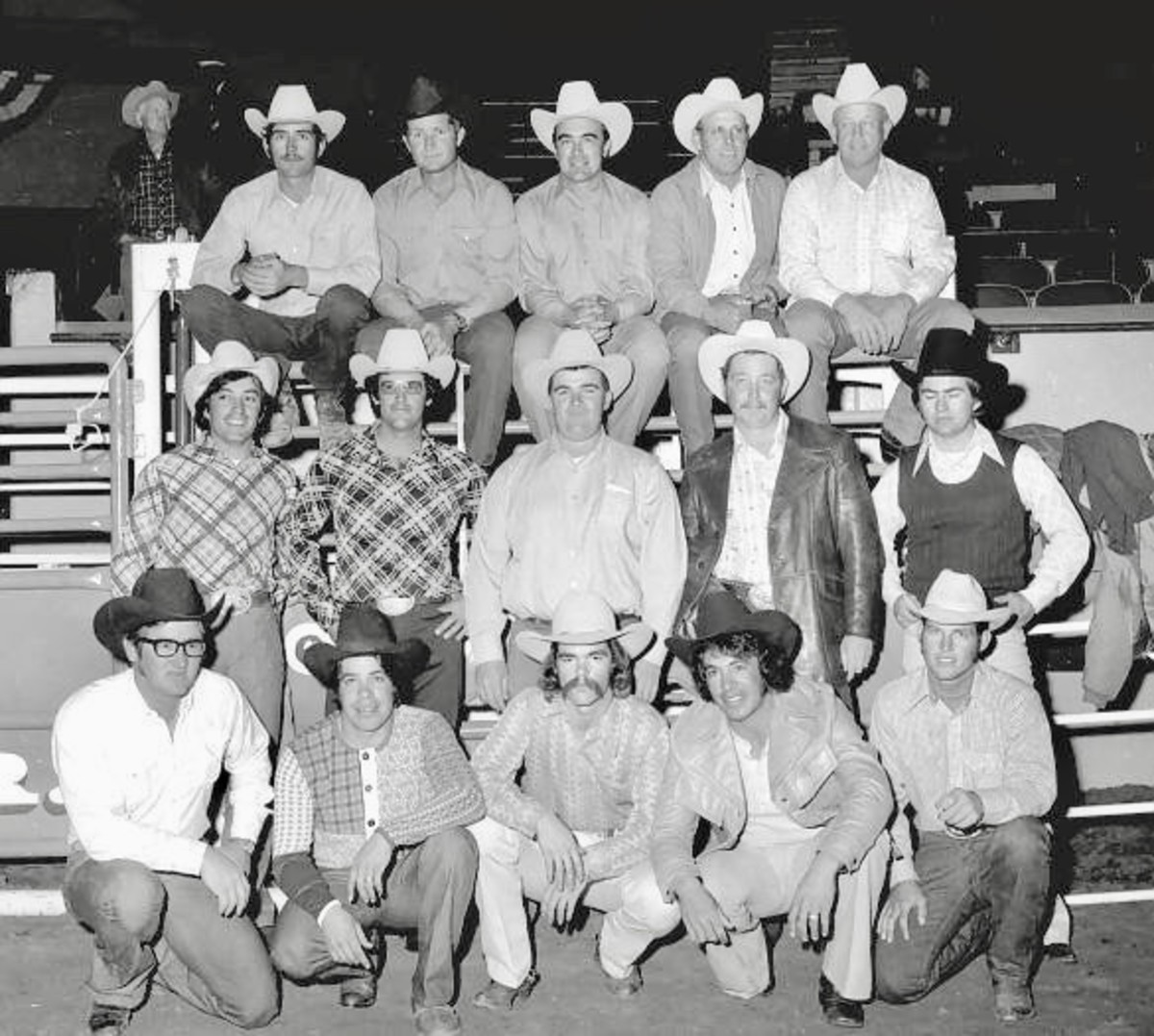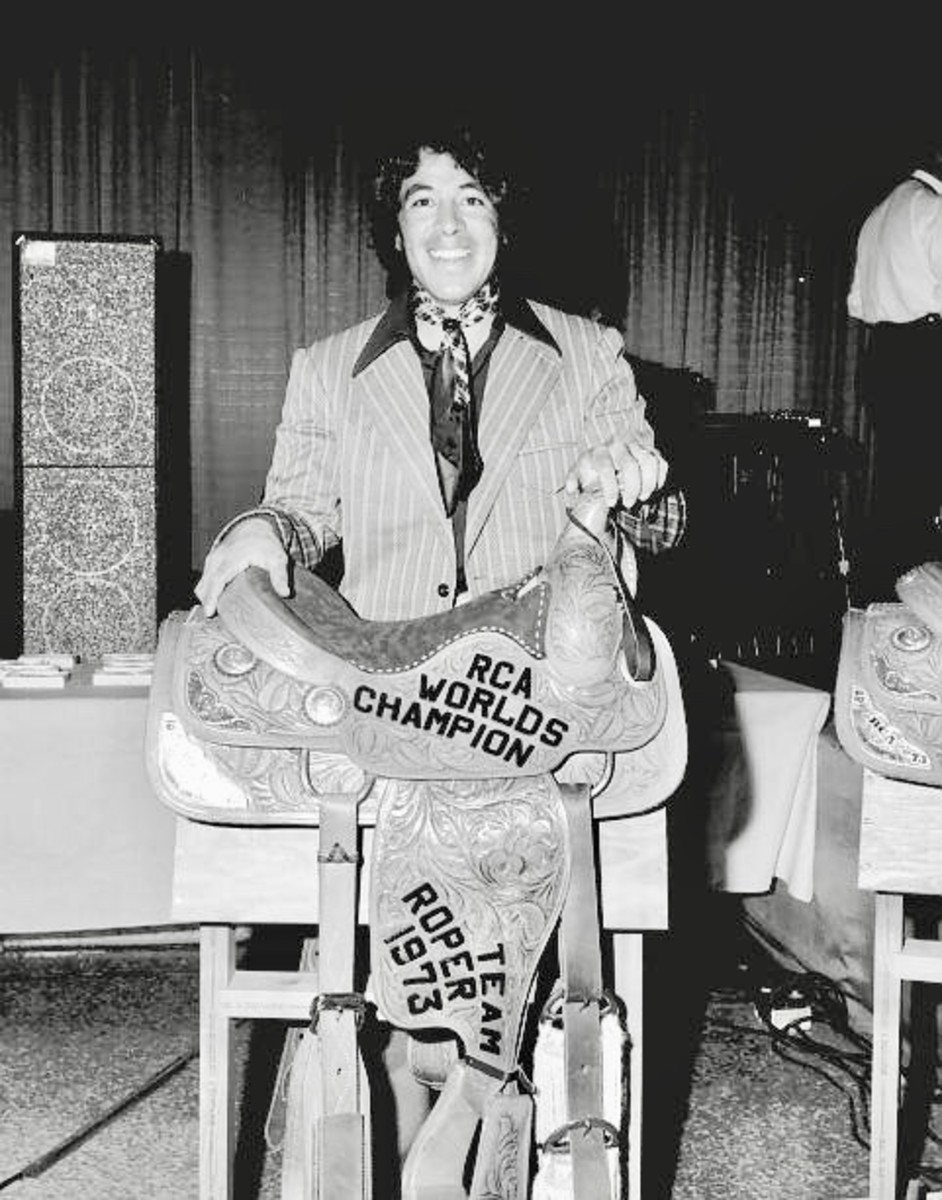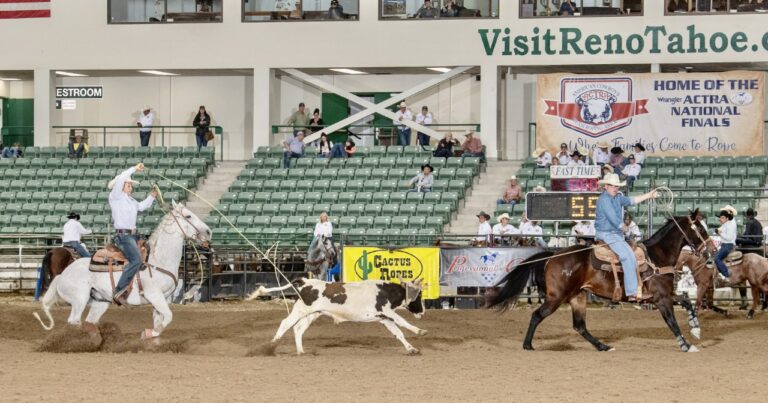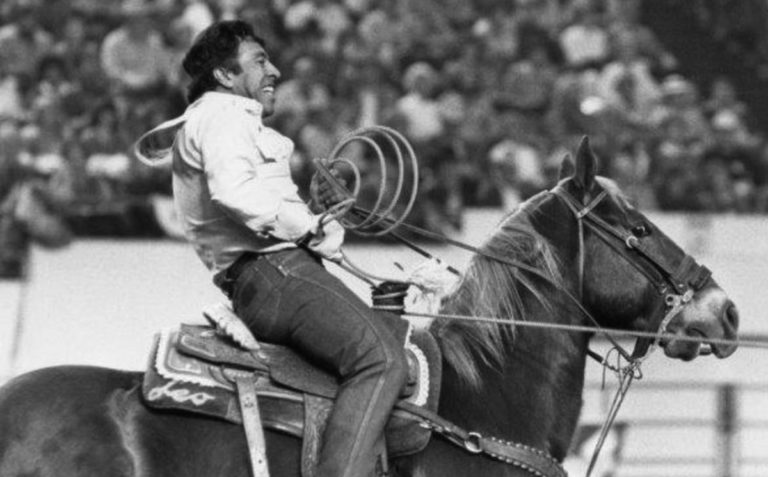On the eve of Prince Harry and Meghan Markle’s royal wedding, how about a fun little Flashback Friday focusing on some team roping royalty? Legendary rodeo photographer Ferrell Butler took these shots of the Top 15 pre-National Finals Rodeo team ropers from 1973, and also that year’s lone world team roping titlist, Leo “The Lion” Camarillo.
What follows are a few fun facts about the group shot and how far team roping has come in the 45 years since these pictures were taken at the Finals in Oklahoma City, along with a little commentary from The Lion himself.

First of all, here’s who you’re looking at:
Front row, left to right, Bucky Bradford, Jerold Camarillo, H.P. Evetts, Leo Camarillo, and Larry Goss.
Middle row, Reg Camarillo, Jim Wheatley, John Bill Rodriguez, Ken Luman, and Gary Gist.
Back row, Arnold Felts, Harry Sloan, Jimmy Rodriguez, Frank Ferreira Sr., and Les Hirdes.
The teams at the 1973 NFR:
Reg Camarillo and Leo Camarillo
H.P. Evetts and Jerold Camarillo
Bucky Bradford and Buck Bradford
Jim Wheatley and John Bill Rodriguez
Jimmy Rodriguez and Ken Luman
Byron Gist and Gary Gist
Arnold Felts and Ace Berry
Larry Goss and Harry Sloan
Les Hirdes and John Deaton
Ron Goodrich and Frank Ferreira Sr.
Doyle Gellerman and Leroy Gellerman
David Motes and Dennis Motes
John Wilken and Dan Branco
Billy Wilson and Tom Miller
Jake Milton and Corky Warren
Family Ties:
Father-son teams: Bradfords, Gellermans, and Gists
Brother teams: Motes
Cousin Teams: Reg and Leo Camarillo
Brothers in the field: Leo and Jerold Camarillo, and Jimmy and John Bill Rodriguez
And no, that’s not the same Tom Miller as the South Dakota saddle bronc rider. This Tom Miller was an Arizona team roper.
Hall of famers in the field: Leo and Jerold Camarillo, Jimmy Rodriguez, Les Hirdes, Ace Berry, and Arnold Felts.
World champions in the field: Leo Camarillo (team roping, 1972-73, ’75, and ’83; all-around, 1975); Jerold Camarillo (1969); Jimmy Rodriguez (1959-60, ’62, and ’65); Les Hirdes (1963); H.P. Evetts, (1974); David Motes (1977); Dennis Motes (1977); Bucky Bradford (1976); Arnold Felts (steer roping, 1976); and Doyle Gellerman (Walt Woodard’s co-champ), 1981.
NFR records set by the team of Rodriguez and Luman at the 1973 NFR: NFR fast time, 5.8, in Round 10; NFR average record of 110.4 seconds on 10.
Total payoff at the 1973 NFR: $121,500
Total attendance at the 1973 NFR, which was held at Oklahoma City’s Jim Norick Arena: 84,230
As for a little Lion commentary…

Kendra Santos: Tell us about the difference in NFR conditions, then and now.
Leo Camarillo: The cattle and the arena were a lot bigger in Oklahoma City than they are in Las Vegas, and the score was longer then than it is today, too. That’s a trend across all the timed events today compared to how it was back in the day. Everything’s gotten smaller and faster. Another big difference is that back then about all of the team ropers were from California and Arizona. Team roping was primitive then, compared to today. It wasn’t as widespread, and it wasn’t a national game, like it is today.
KS: What was your NFR strategy in 1973?
LC: Catch. I was raised that way (by his ranch cowboy extraordinaire dad, Ralph). Traditionally, and the way I was brought up, it was all about the average.
KS: Would your strategy be any different today?
LC: Not really. I still think that if you just catch 10 steers you will win the lion’s share of the money.
KS: At that time, and as that group shot shows, the RCA only acknowledged the Top 15 individual team ropers instead of the 30 guys it takes to make an NFR team roping field. The Top 15 at regular-season’s end got to pick their NFR partner, as opposed to how it is today, where 15 headers and 15 heelers qualify for the Finals. How do you feel about our sport’s evolution in that area?
LC: I think they finally got it right. The 15 best headers and the 15 best heelers should qualify for the National Finals. You have to remember that team roping was a stepchild event back then. Team ropers weren’t even included in the first three NFRs in Dallas (true that; the team roping finals was held separately, in Clayton, New Mexico, in 1959; Scottsdale, Arizona, in 1960; and Santa Maria, California, in 1961; team roping caught up to the rest of the events starting at the 1962 NFR in Los Angeles). And there should be a world champion header and a world champion heeler. The headers compete all year long against the other headers, and the heelers do the same.
KS: If they’d crowned a world champion header that year, it would have been H.P. Same goes for years like, say, 1974, when had they crowned a world champion heeler, it would have been you. For those who weren’t there then, explain how not all rodeos even included team roping then, and how some let you guys go twice.
LC: Some of the bigger team roping rodeos, like Salinas and Santa Maria, were never go twice. But in some of the smaller towns, they sometimes only got 30 teams when it was go twice. I usually roped with Reg and H.P. when it was go twice. I won $20,693 in the team roping in 1973. So I didn’t exactly go out and buy a ranch. But back then, only about 10 percent of the RCA rodeos had team roping. There were about 600-700 rodeos in the RCA at that time, and only about 60 of them had team roping.
KS: What do you remember about winning that second straight gold buckle in 1973?
LC: I’d won four National Finals averages in a row (1968-71; in 1968 with Billy Wilson, then three in a row with Reg; Leo holds the all-time NFR team roping average wins record with six, including two more in 1980 and ’82 with Tee Woolman), but I hadn’t won a world title before 1972. On the street they were saying I wasn’t capable of winning a world championship, and that I was just lucky to win at the National Finals. “That’s just his rodeo” was the rumor. I was always roping calves and bulldogging, too, and working all the events and making a living was the priority. Working three events was also hard on a team roping partner. Trevor Brazile’s partners can relate to a degree, but at least they have team roping at every rodeo now. Winning the world in 1972 and quieting that rumor was pretty satisfying. Winning it a second straight year in 1973 was even better. Vince Lombardi was one of my heroes. He was considered one of the greatest coaches of all time. He won the very first Super Bowl (in 1966). Then he (and his Green Bay Packers) won it again the next year (1967). Then he died (in 1970). The trophy they win at the Super Bowl today is the Vince Lombardi Trophy. Anyway, that kind of gave that accomplishment special meaning to me.
KS: Last but certainly not least, you’ve got to give us some insight into that fashion statement when you were crowned the 1973 champ. I remember Stick’s main man sporting starched, monogrammed shirts. But you were really stylin’ at that awards ceremony.
LC: I finally got to clean up, and long hair was in style. I’ve always watched a lot of basketball, and one of my all-time favorite players was Walt Frazier, who played for the New York Knicks. They called him Clyde, and he had swagger. He wore striped suits, and dressed to the nines. I think I was trying to be like Clyde.










